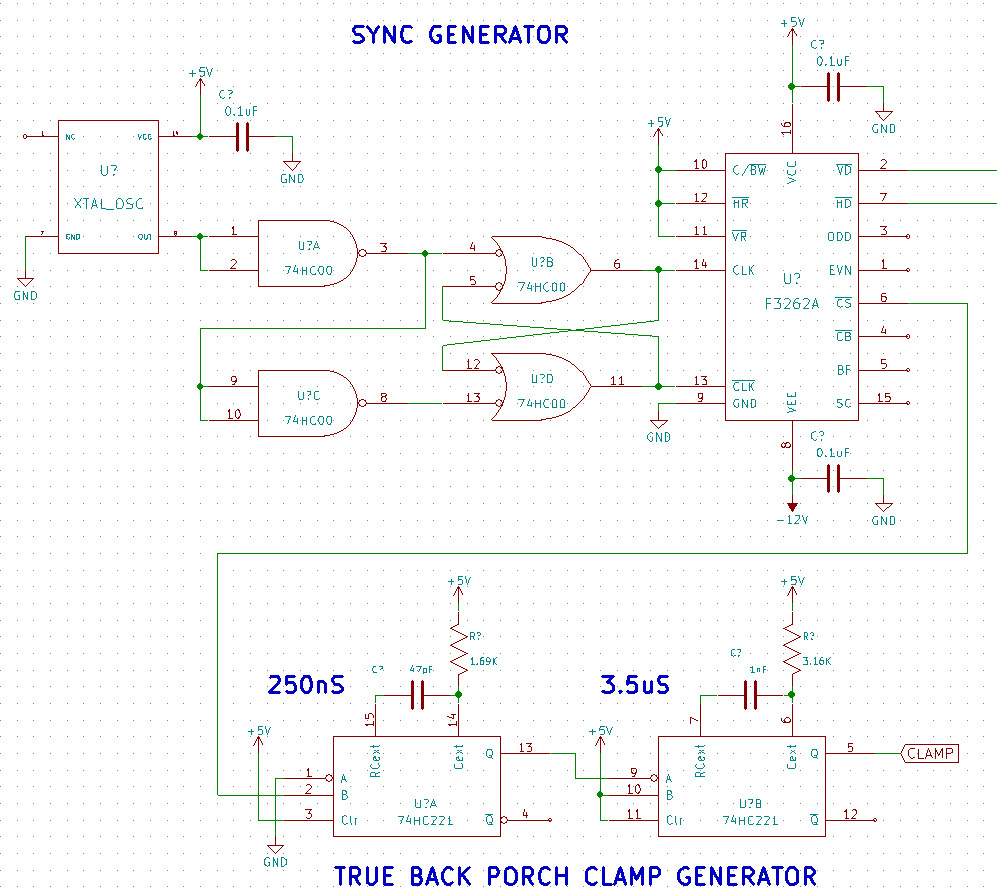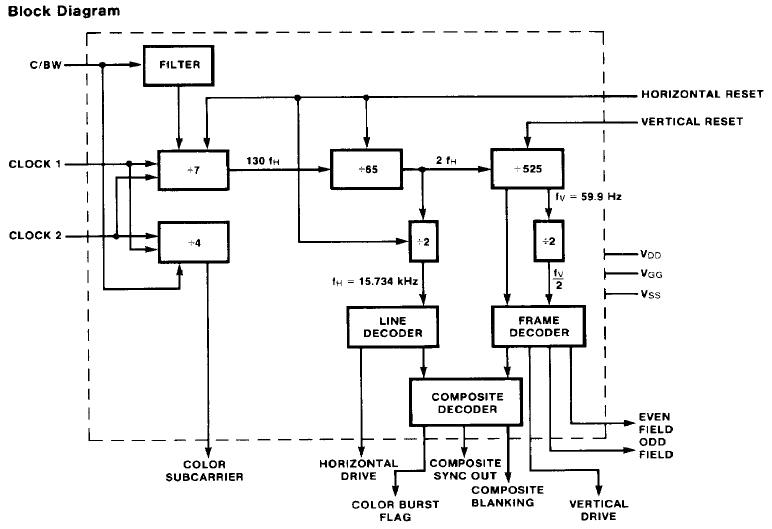LabGuy's World: The Chief, Part 3 - Sync Generator

A piece of history by the Fairchild Corporation, F3262A TV sync generator IC, 1970s The function of the television sync generator is to produce the precise timing pulses required for producing a coherent video signal. There are requirements for starting the horizontal and vertical scanning, blanking the electron beam in the image tube during retrace, blanking for the video amp chain and other funtions. True clamping pulses, for DC restoration of the video signal, are generated by a separate dual monostable multivibrator. This clamp pulse samples the blanking level that follows the rising edge of ALL sync pulse, equalizing and serration pulses. This makes for a vertical interval that does not have a DC jag in it like many inferior circuits produce. A chain of binary counters is driven by a bi-phase clock at a frequency of 14.31818 MHz. This is four times the NTSC color subcarrier frequency of 3.579545 MHz. Conveniently, the 14 MHz clock can be divided by 910 to give us horizontal sync. It is actually divided by 455 (910/2) and then again divided by 2. In this way, the 455 diviser gives us a 2H pulse which is divided by 525 to produce vertical sync pulses. At the start of FRAME, and FIELD 1, the vertical sync and horizontal sync are in phase. In the middle of FRAME, at the start of FIELD 2, the vertical sync pulse falls in between two H sync pulses. Lines number 262 and 263 to be precise. Doesn't 262.5 sound familiar to you? This is how half line field offset is obtained. These are great single chip sync generators for EIA/NTSC. Made by Fairchild in the 1980s by their special functions division. Fairchild Corp. surveyed a number of engineers in the industry about which medium complexity circuits they found themselves constantly using. A television sync pulse generator was high on the list. And it was a perfect fit for the medium scale IC complexity of that era. Almost all other sync generator ICs, since then, have been computer oriented and require complex programming by a microcontroller at start up. The Fairchild 3262A is instant on and Labguy likes that. This project uses the 3262A part. There was also a B version. It differs in the way that it can be synchronized to an external reference. I have not tried it. But, the B version looks easier to implement this function. My first video circuit design, as a junior enginer in 1984, was to create a special quad sync system for timing two cameras and two television monitors for use in a massive video conferencing system purchased by Ross Perot's company, EDS. I had to push the video from two cameras through a single MPEG video codec and then de-assemble the pictures and show them on two monitors at the receiving end. What you youngsters don't know is that an MPEG codec was a 19" equipment rack five feet tall and cost nearly $100,000 with its mating twin, the receiver. That's right. A codec that runs for free in software on your phone today, filled two hideously expensive refrigerator sized cabinets in the mid 1980s! The sync generator is the same one I use in all of my video project, the Fairchild 3262A. These are available in quantity from the seller, voyagercomponents on Ebay. As of March 2019, the auction number is: 252737560266. For quantity purchases, contact Voyager Components,in Oregon, directly. VOYAGER COMPONENTS, 1208 ESKA WAY, Silverton, OR 97381. Telephone (503)873-4499. Ask for Demetri. Confuse Demetri by telling him Labguy sent you. [HOME] [ELECTRONICS PROJECTS] [THE CHIEF TOP] [NEXT PAGE] |